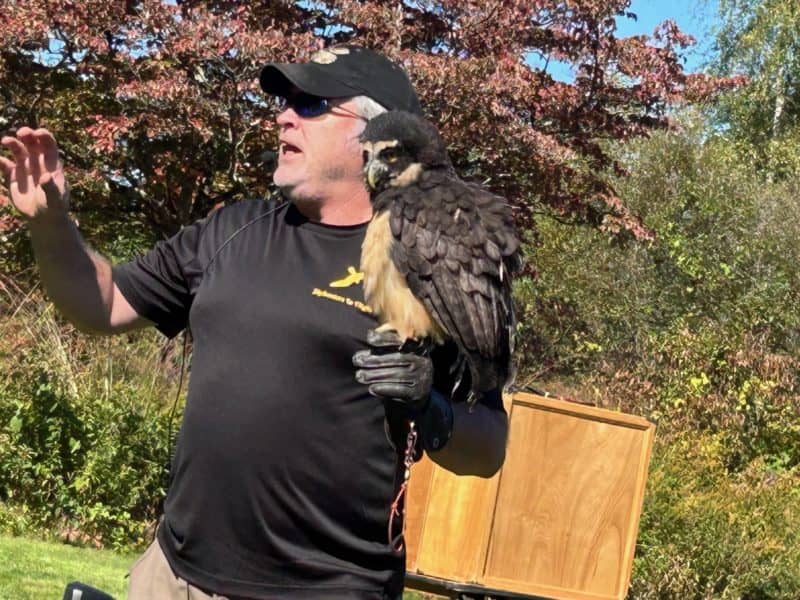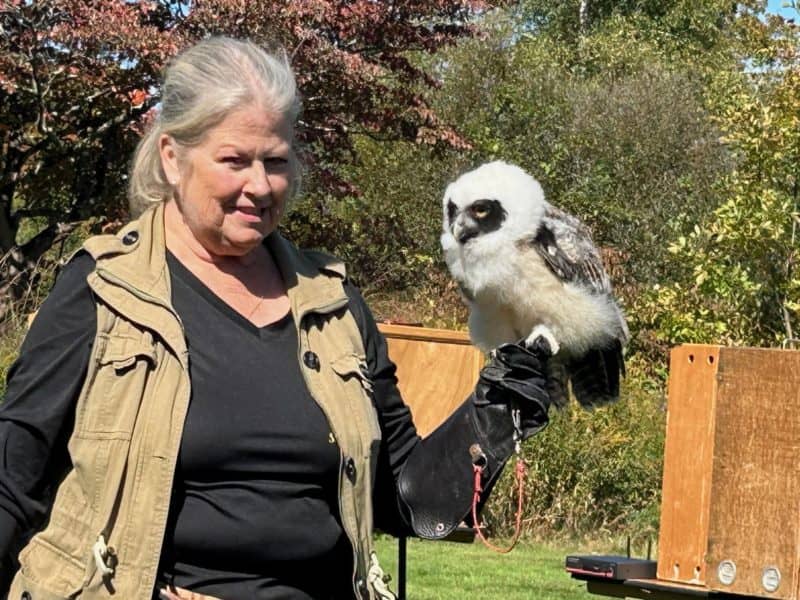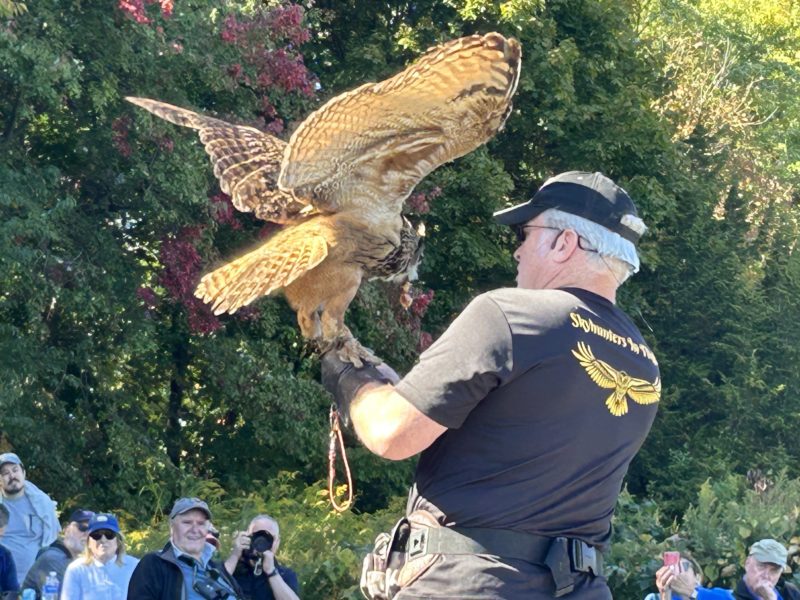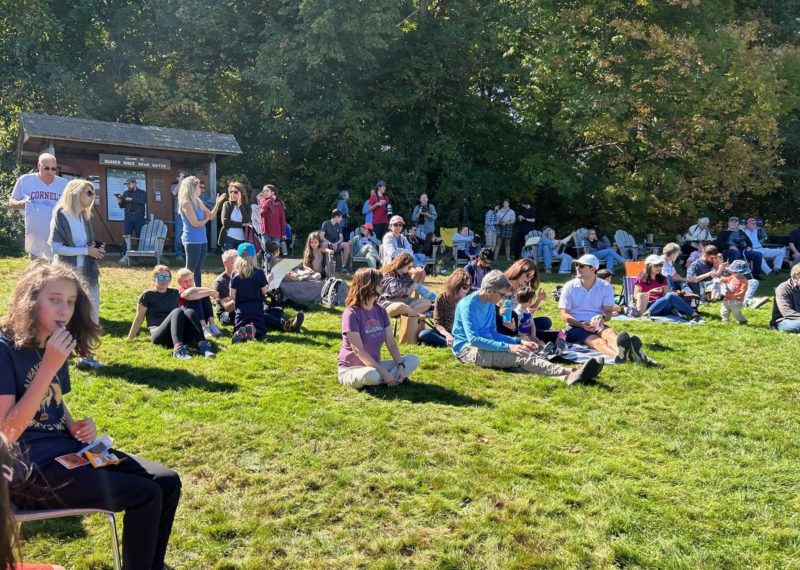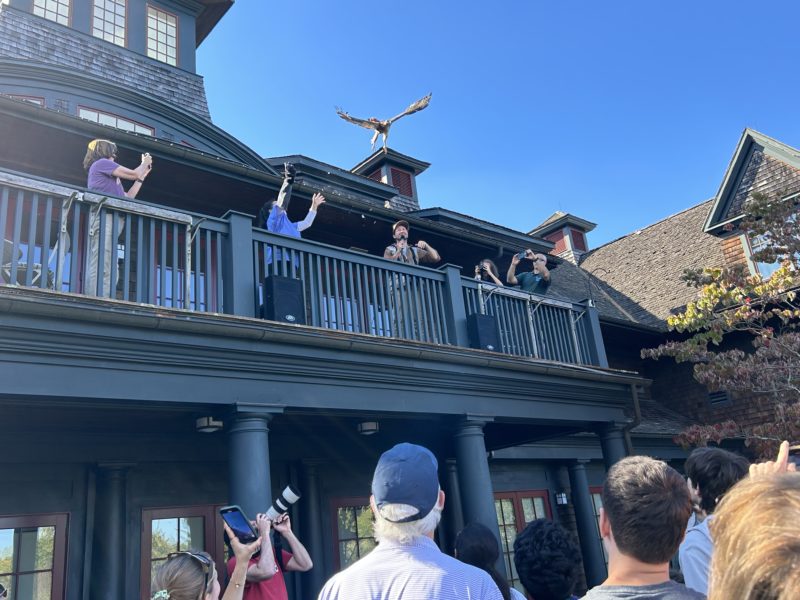
By Anne W. Semmes
Over two brilliantly sunny clear-sky days hundreds of folks were able to get up close and personal with a variety of hawks and raptors at Greenwich Audubon’s annual Hawk Watch migration celebration last weekend. Especially engaging on Sunday afternoon was the presentation of live performing birds of prey – with returning master falconer Brian Bradley and his wife Teddy of Skyhunters in Flight.
Welcoming the crowd perching across the lawn outside the Audubon Center was Bird Education Specialist Ryan MacLean. “Brian and Teddy Bradley of Skyhunters have an amazing up-close presentation,” he said, “but so important is it to learn a few rules. These are birds that can get easily scared by people. So, we want to make sure everyone is sitting still, and parents make sure you have kids close by and are holding onto them, so no one is running up this way towards the birds.”
Bradley began with a warning on this bird migration day, “There’ll certainly be some birds coming through here, and when I fly my birds, it could get interesting because trust me they’re not pals out there in nature. These birds migrating through are hungry and they see my birds as a meal…So, I always have to be aware of that. But before we get into the particulars of each individual bird, you’re going to see how important [sky hunting] predators are to the environment.”
“These birds have a strong immune system…So they’re able to eat a sick rodent and not become sick themselves. So, they remove that animal from the group, stop it from spreading disease… They also control the numbers of all those animals, which is one of the most important things they can do.” And “what defines them as birds of prey – powerful feet and sharp claws or talons for catching and killing their prey…everything about that bird helps it survive.”
So, there are day hunters and night hunters, Bradley continued, “And we’re going to start with a night hunter…These birds were bred in captivity…I’ve handpicked them from a young age and trained them to do what we do here today, which is hopefully entertain and educate.” Teddy Bradley brought forward a Spectacle Owl. “Its face like a pair of glasses,” said Bradley, and was eight weeks old. “They’re what we call an exotic, born somewhere else in the world.” This one from a breeder in New York.
“Hunting especially is learned behavior,” told Bradley. “They’ve got the hardest job out there. It’s said that 70 to 80 percent of all young birds of prey…do not survive their first year… because they don’t have the athletic ability, the speed, strength, endurance, the skills, the mental acuity to be able to catch prey on a regular basis…Nature simply picks out the best of the best to pass along their genes into future generations to make those species stronger as a whole.”
With wife Teddy now introducing the young owl up close Bradley added an “old Spectacle Owl… It shows you how much a bird can change in plumage, feather change, coloration and so forth.” The young owl’s “white stuff covering his head and upper body keeps him warm.” But “underneath the adult feathers are growing in and in a matter of months she’s going to look just like this old girl does. She’s 21 years old this summer.”
“So, they get over their natural instinctive fear and she trusts me,” noted Bradley. “She doesn’t trust anyone else. So, when I scratch her on the head, it takes her mind off her nerves. I read her body language. I may be talking to you, but I can tell you half of my brain is monitoring what the bird is doing on the glove at all times.”
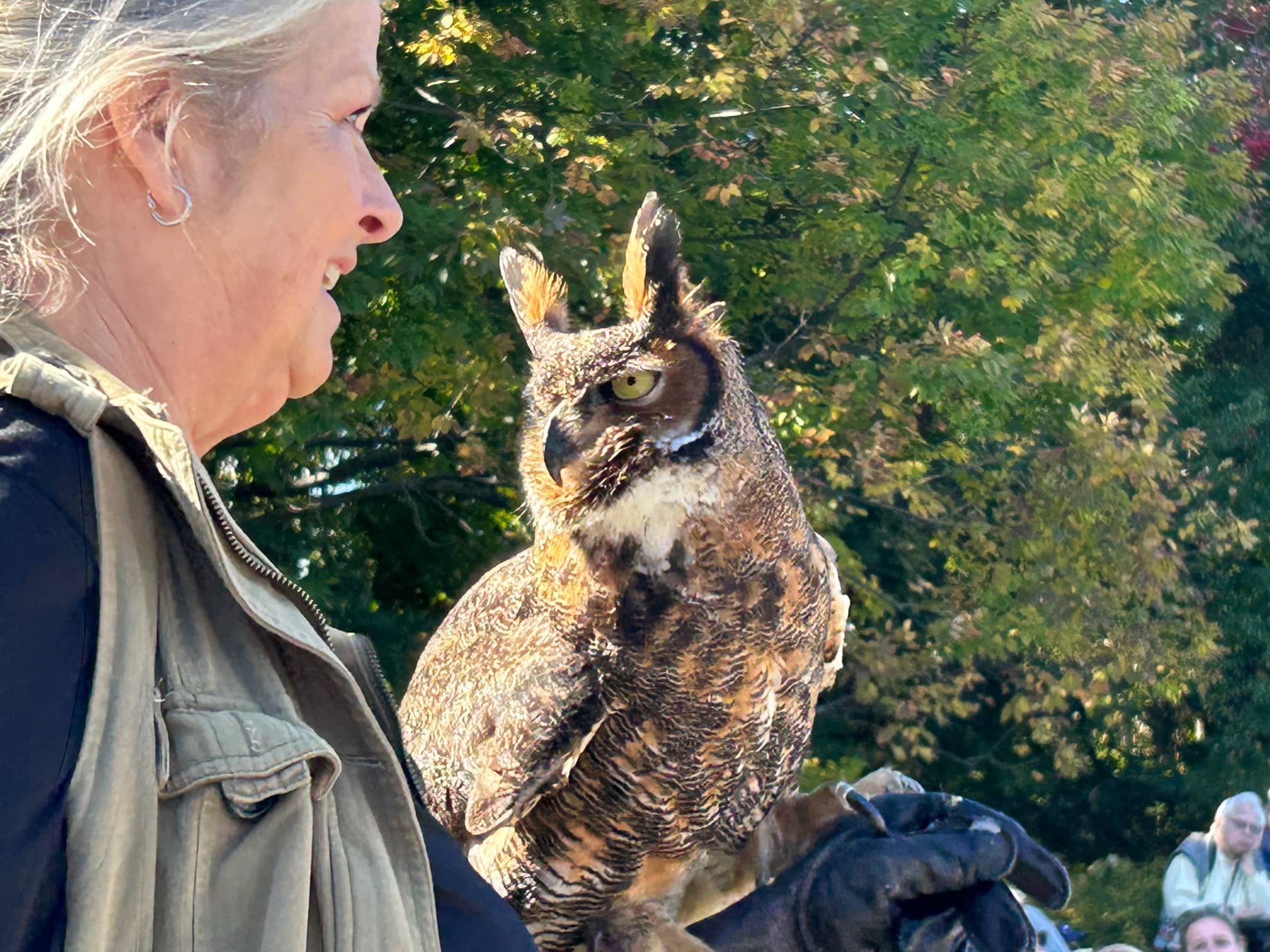
Up next was the Great Horned Owl. “Definitely the largest owl that we have in our area,” said Teddy Bradley. “It’s all feathers, that big head, all of it all feathers.” And why that name?
“Because of that tuft of feathers on top of the head,” said Bradley, “But obviously they’re just feathers, and some people say they can confer a mood. The bird can lay them down, make them disappear, stick them straight up. One of the things that I know that they do is help that bird maintain camouflage in the forest because that is a bird of our deep forest.” And that Horned Owl was a female. “She’s a big powerful bird…In the world of birds of prey, females are always roughly one third larger and more powerful than the males in all species. That allows females to catch larger prey while a male can catch smaller, more maneuverable prey.”
There followed a Great Gray Owl without that tuft of feathers on the head. And next up was an eight-month-old Barn Owl. “Stealth is the number one most important thing,” said Bradley “that owls have going for them.” And “They will often sit very still like a statue and turn just that head smoothly in all directions so as not to attract attention.” What of that swiveling owl’s head? “They can’t turn their head 360 degrees – it’s roughly 270 degrees, but that does give them a wide field of view.”
Then suddenly that young Barn Owl was unhooked and flew into the trees, causing squeals from some little ones. But that owl was properly trained to return to its food gift on Bradley’s glove. “That’s the first time he’s ever flown free in front of an audience,” said Bradley, and “My heart was pounding out of my chest because if he goes up into a tree and decides to sit up there and go home…So very proud of him. Good job.”
The last Skyhunters act was especially gripping with the release of two Harris Hawks into the surrounding trees programmed to pursue a “rabbit” lure. The audience was divided into two sections with each assigned to shout out the name of one of the hawks – Rip or Cash to trigger their flights from the trees to that lure. The callout to Rip brought a swift flight to that lure.
But the younger Cass “banked off and went through a tree,” shared Bradley, perhaps spooked by “that funky looking off-road vehicle parked nearby.” “But he’ll get over that,” added Bradley, the hawk safely returned to his glove.
The day ended with remarks by MacLean of the comeback of the Hawk Watch Weekend post Covid with the weekend attendance of 400, “our highest since 2019.”
The finale was a release to the wild of a hawk brought back to life by the care of Wildlife in Crisis having been hit by a car with head and wing injuries. Held by caregiver Willow Reid above onlookers, the hawk was released to immediately taking flight, fast disappearing into freedom.
